Introduction to installing PHP7 in Linux environment
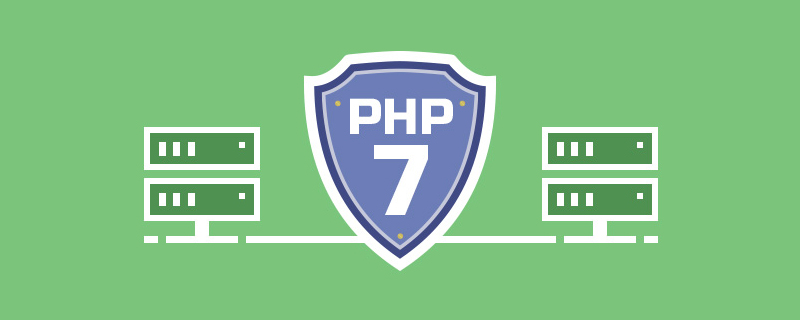
Recommended (free): PHP7
Download
# wget http://php.net/get/php-7.0.2.tar.gz/from/a/mirror
Unzip and install
# tar zxvf php-7.0.2.tar.gz# cd php-7.0.2
First check the installation help
# ./configure --help # ./configure --prefix=/usr/local/php \ --with-curl \ --with-freetype-dir \ --with-gd \ --with-gettext \ --with-iconv-dir \ --with-kerberos \ --with-libdir=lib64 \ --with-libxml-dir \ --with-mysqli \ --with-openssl \ --with-pcre-regex \ --with-pdo-mysql \ --with-pdo-sqlite \ --with-pear \ --with-png-dir \ --with-xmlrpc \ --with-xsl \ --with-zlib \ --enable-fpm \ --enable-bcmath \ --enable-libxml \ --enable-inline-optimization \ --enable-gd-native-ttf \ --enable-mbregex \ --enable-mbstring \ --enable-opcache \ --enable-pcntl \ --enable-shmop \ --enable-soap \ --enable-sockets \ --enable-sysvsem \ --enable-xml \ --enable-zip
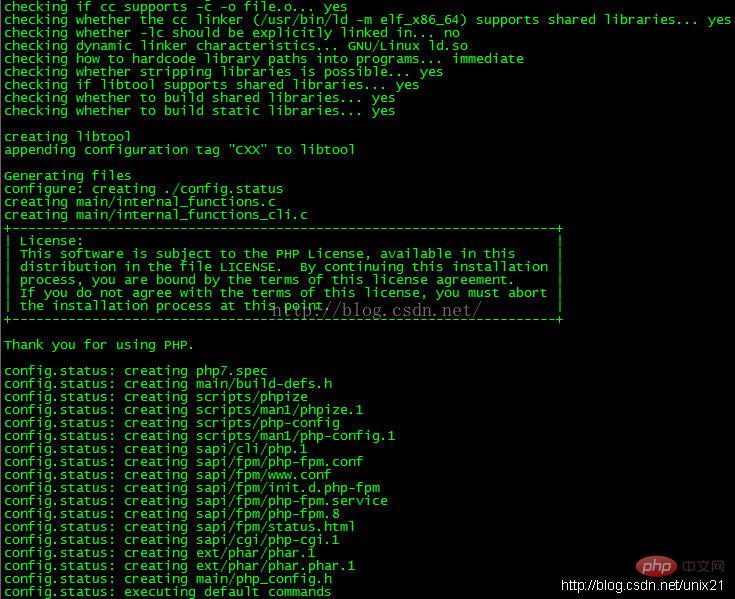
If the configuration is wrong, you need to install the required modules, directly yum and install the dependent libraries together
# yum -y install libjpeg libjpeg-devel libpng libpng-devel freetype freetype-devel libxml2 libxml2-devel MySQL pcre-devel
Note: Installation In php7beta3, there were several configurations that couldn't be configured, and you needed to yum them. This is no longer the case with php-7.0.2.
# yum -y install curl-devel# yum -y install libxslt-devel
Compile and install
# make && make install
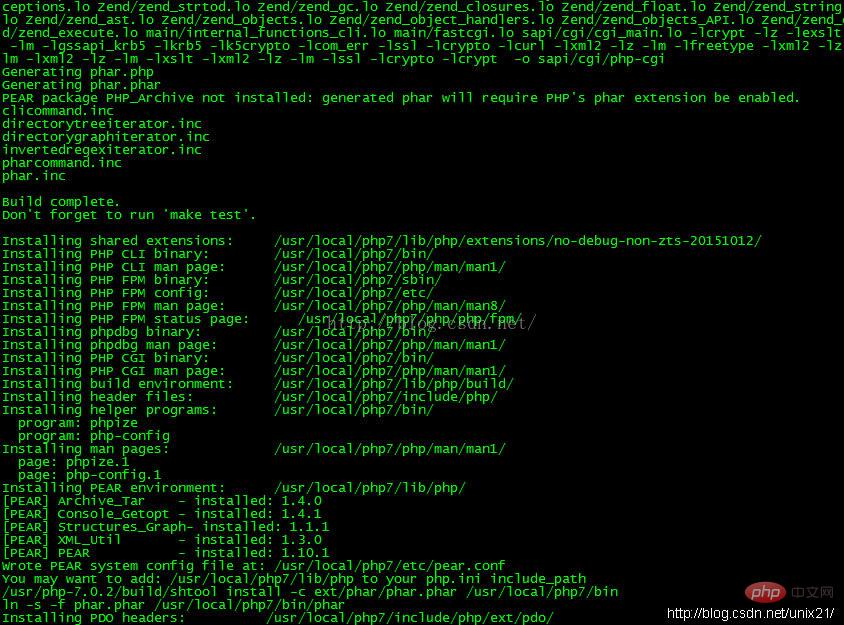
Configuration file
# cp php.ini-development /usr/local/php/lib/php.ini# cp /usr/local/php/etc/php-fpm.conf.default /usr/local/php/etc/php-fpm.conf# cp /usr/local/php/etc/php-fpm.d/www.conf.default /usr/local/php/etc/php-fpm.d/www.conf# cp -R ./sapi/fpm/php-fpm /etc/init.d/php-fpm
It should be noted that the configuration file www.conf in php7 configures the port of phpfpm number and other information, if you change the default 9000 port number, you need to change it here, and then change the nginx configuration
Start
# /etc/init.d/php-fpm
View phpinfo() 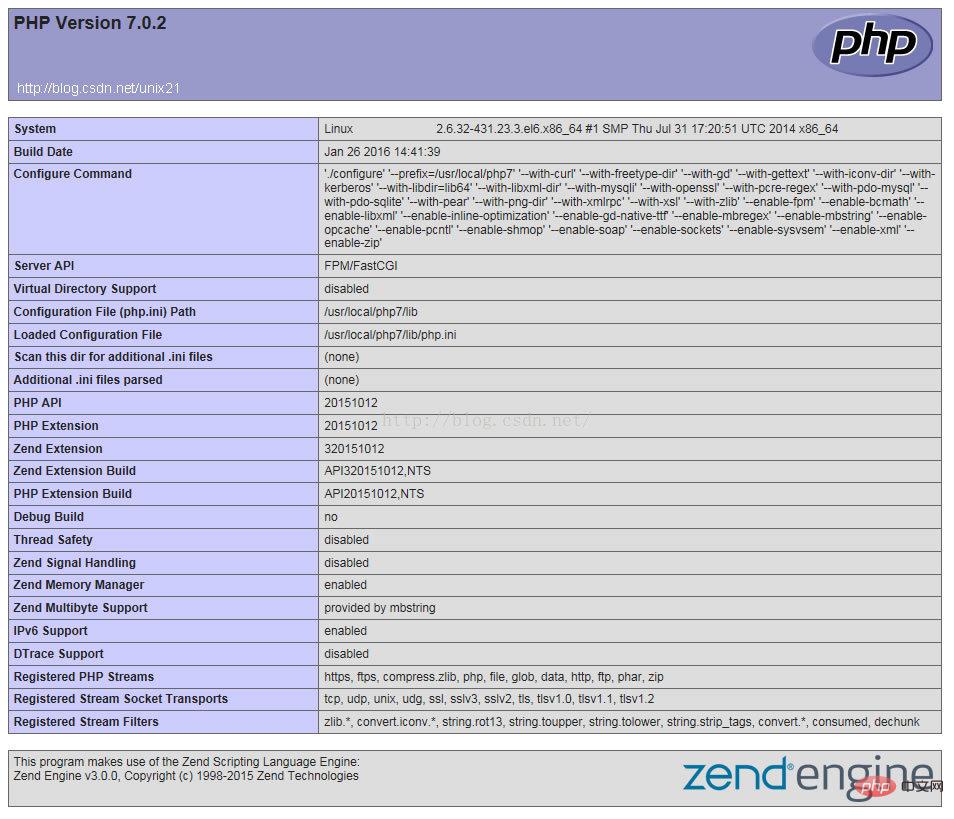
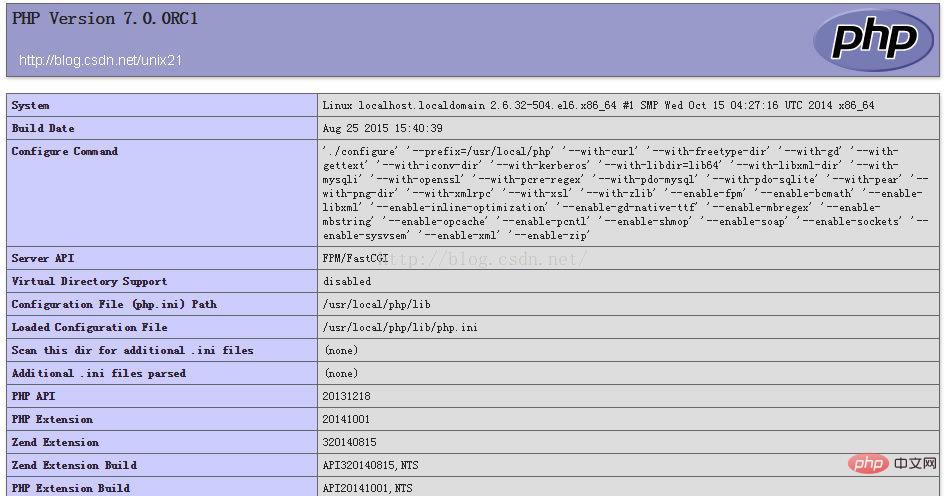
Performance analysis comparison between php7 and php5
<?php //time /usr/local/php5/bin/php search_by_key.php $a = array();
for($i=0;$i<600000;$i++){
$a[$i] = $i;
}
foreach($a as $i)
{
array_key_exists($i, $a);
}
?>Generate an array of 600,000 elements, and determine whether the key exists by searching for the key.
PHP 5.4.44 版 [root@localhost www5.4.44]# time /usr/local/php5.4.44/bin/php search_by_key.phpreal 0m0.351s user 0m0.300s sys 0m0.050sPHP 5.5.28 版 [root@localhost www]# time /usr/local/php/bin/php search_by_key.phpreal 0m0.361s user 0m0.304s sys 0m0.057sPHP 7.0.0 版 [root@localhost www7]# time /usr/local/php7/bin/php search_by_key.phpreal 0m0.114s user 0m0.097s sys 0m0.017s
Obviously the performance of php7 is 3 times that of php5!
Configure opcache
Official website address: http://php.net/opcache
Use the following recommended settings to get better performance:
opcache.memory_consumption=128opcache.interned_strings_buffer=8opcache.max_accelerated_files=4000opcache.revalidate_freq=60opcache.fast_shutdown=1opcache.enable_cli=1
You can also disableopcache.save_comments and enable opcache.enable_file_override. It should be reminded that the above configuration must be rigorously tested before being used in a production environment. Because there is a known issue with the above configuration, it will cause exceptions in some frameworks and applications, especially when there are documents using comment annotations.
vim /usr/local/php7/etc/php.ini# 加入zend_extension=/usr/local/php7/lib/php/extensions/no-debug-non-zts-20141001/opcache.so
Restart
# killall php-fpm# /etc/init.d/php-fpm
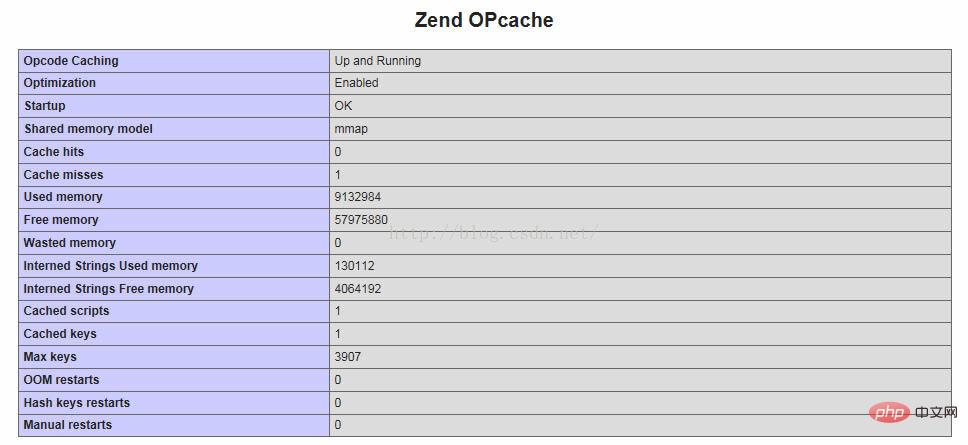
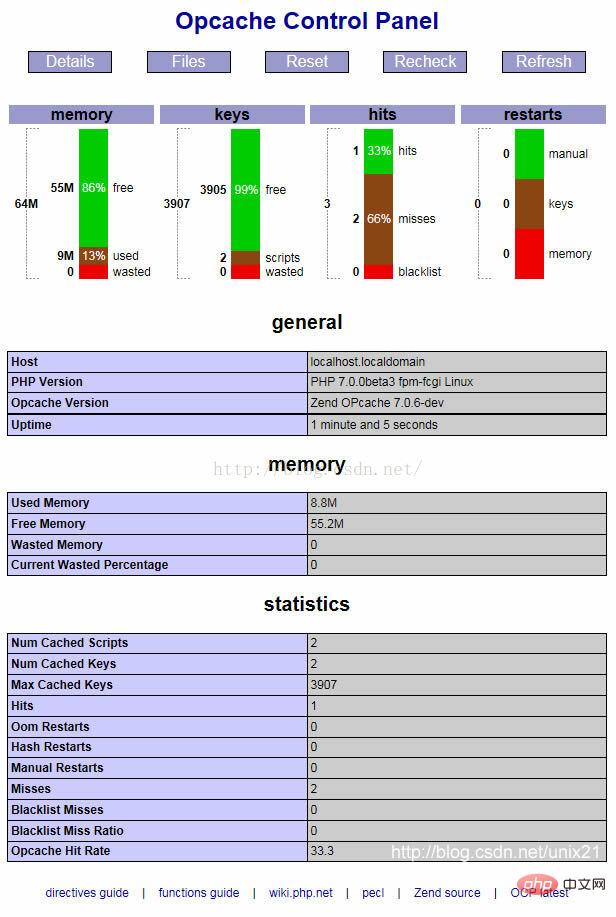
The above is the detailed content of Introduction to installing PHP7 in Linux environment. For more information, please follow other related articles on the PHP Chinese website!

Hot AI Tools

Undresser.AI Undress
AI-powered app for creating realistic nude photos

AI Clothes Remover
Online AI tool for removing clothes from photos.

Undress AI Tool
Undress images for free

Clothoff.io
AI clothes remover

Video Face Swap
Swap faces in any video effortlessly with our completely free AI face swap tool!

Hot Article

Hot Tools

Notepad++7.3.1
Easy-to-use and free code editor

SublimeText3 Chinese version
Chinese version, very easy to use

Zend Studio 13.0.1
Powerful PHP integrated development environment

Dreamweaver CS6
Visual web development tools

SublimeText3 Mac version
God-level code editing software (SublimeText3)

Hot Topics
 1666
1666
 14
14
 1425
1425
 52
52
 1323
1323
 25
25
 1272
1272
 29
29
 1251
1251
 24
24
 Linux Architecture: Unveiling the 5 Basic Components
Apr 20, 2025 am 12:04 AM
Linux Architecture: Unveiling the 5 Basic Components
Apr 20, 2025 am 12:04 AM
The five basic components of the Linux system are: 1. Kernel, 2. System library, 3. System utilities, 4. Graphical user interface, 5. Applications. The kernel manages hardware resources, the system library provides precompiled functions, system utilities are used for system management, the GUI provides visual interaction, and applications use these components to implement functions.
 How to check the warehouse address of git
Apr 17, 2025 pm 01:54 PM
How to check the warehouse address of git
Apr 17, 2025 pm 01:54 PM
To view the Git repository address, perform the following steps: 1. Open the command line and navigate to the repository directory; 2. Run the "git remote -v" command; 3. View the repository name in the output and its corresponding address.
 vscode Previous Next Shortcut Key
Apr 15, 2025 pm 10:51 PM
vscode Previous Next Shortcut Key
Apr 15, 2025 pm 10:51 PM
VS Code One-step/Next step shortcut key usage: One-step (backward): Windows/Linux: Ctrl ←; macOS: Cmd ←Next step (forward): Windows/Linux: Ctrl →; macOS: Cmd →
 How to run java code in notepad
Apr 16, 2025 pm 07:39 PM
How to run java code in notepad
Apr 16, 2025 pm 07:39 PM
Although Notepad cannot run Java code directly, it can be achieved by using other tools: using the command line compiler (javac) to generate a bytecode file (filename.class). Use the Java interpreter (java) to interpret bytecode, execute the code, and output the result.
 How to run sublime after writing the code
Apr 16, 2025 am 08:51 AM
How to run sublime after writing the code
Apr 16, 2025 am 08:51 AM
There are six ways to run code in Sublime: through hotkeys, menus, build systems, command lines, set default build systems, and custom build commands, and run individual files/projects by right-clicking on projects/files. The build system availability depends on the installation of Sublime Text.
 What is the main purpose of Linux?
Apr 16, 2025 am 12:19 AM
What is the main purpose of Linux?
Apr 16, 2025 am 12:19 AM
The main uses of Linux include: 1. Server operating system, 2. Embedded system, 3. Desktop operating system, 4. Development and testing environment. Linux excels in these areas, providing stability, security and efficient development tools.
 laravel installation code
Apr 18, 2025 pm 12:30 PM
laravel installation code
Apr 18, 2025 pm 12:30 PM
To install Laravel, follow these steps in sequence: Install Composer (for macOS/Linux and Windows) Install Laravel Installer Create a new project Start Service Access Application (URL: http://127.0.0.1:8000) Set up the database connection (if required)
 git software installation
Apr 17, 2025 am 11:57 AM
git software installation
Apr 17, 2025 am 11:57 AM
Installing Git software includes the following steps: Download the installation package and run the installation package to verify the installation configuration Git installation Git Bash (Windows only)




